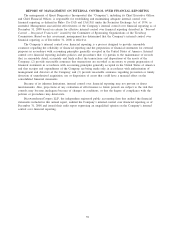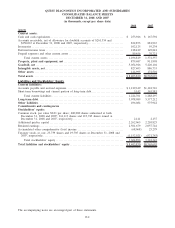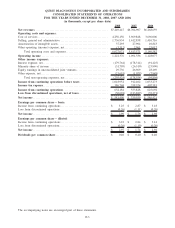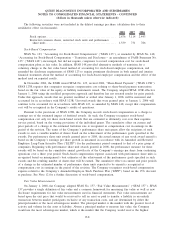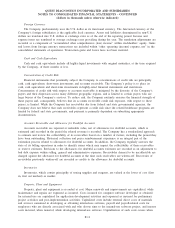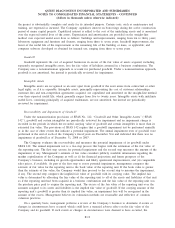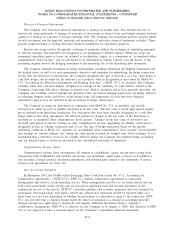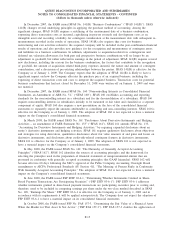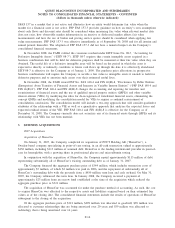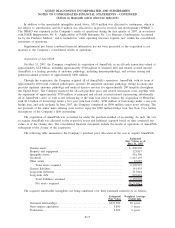Quest Diagnostics 2008 Annual Report Download - page 80
Download and view the complete annual report
Please find page 80 of the 2008 Quest Diagnostics annual report below. You can navigate through the pages in the report by either clicking on the pages listed below, or by using the keyword search tool below to find specific information within the annual report.
The following securities were not included in the diluted earnings per share calculation due to their
antidilutive effect (in thousands):
2008 2007 2006
Stock options....................................................... 2,676 3,114 2,443
Restricted common shares, restricted stock units and performance
share units ....................................................... 1,339 731 786
Stock-Based Compensation
SFAS No. 123, “Accounting for Stock-Based Compensation” (“SFAS 123”), as amended by SFAS No. 148,
“Accounting for Stock-Based Compensation – Transition and Disclosure – an amendment of FASB Statement No.
123” (“SFAS 148”) encouraged, but did not require, companies to record compensation cost for stock-based
compensation plans at fair value. In addition, SFAS 148 provided alternative methods of transition for a
voluntary change to the fair value based method of accounting for stock-based employee compensation, and
amended the disclosure requirements of SFAS 123 to require prominent disclosures in both annual and interim
financial statements about the method of accounting for stock-based employee compensation and the effect of the
method used on reported results.
In December 2004, the FASB issued SFAS No. 123, revised 2004, “Share-Based Payment” (“SFAS 123R”).
SFAS 123R requires that companies recognize compensation cost relating to share-based payment transactions
based on the fair value of the equity or liability instruments issued. The Company adopted SFAS 123R effective
January 1, 2006 using the modified prospective approach and therefore has not restated results for prior periods.
Under this approach, awards that are granted, modified or settled after January 1, 2006 will be measured and
accounted for in accordance with SFAS 123R. Unvested awards that were granted prior to January 1, 2006 will
continue to be accounted for in accordance with SFAS 123, as amended by SFAS 148, except that compensation
cost will be recognized in the Company’s results of operations.
Pursuant to the provisions of SFAS 123R, the Company records stock-based compensation as a charge to
earnings net of the estimated impact of forfeited awards. As such, the Company recognizes stock-based
compensation cost only for those stock-based awards that are estimated to ultimately vest over their requisite
service period, based on the vesting provisions of the individual grants. The cumulative effect on current and
prior periods of a change in the estimated forfeiture rate is recognized as compensation cost in earnings in the
period of the revision. The terms of the Company’s performance share unit grants allow the recipients of such
awards to earn a variable number of shares based on the achievement of the performance goals specified in the
awards. For performance share unit awards granted prior to 2008, the actual amount of any stock award earned is
based on the Company’s earnings per share growth as measured in accordance with its Amended and Restated
Employee Long-Term Incentive Plan (“ELTIP”) for the performance period compared to that of a peer group of
companies. Beginning with performance share unit awards granted in 2008, the performance measure for these
awards will be based on the cumulative annual growth rate of the Company’s earnings per share from continuing
operations over a three year period. Stock-based compensation expense associated with performance share units is
recognized based on management’s best estimates of the achievement of the performance goals specified in such
awards and the resulting number of shares that will be earned. The cumulative effect on current and prior periods
of a change in the estimated number of performance share units expected to be earned is recognized as
compensation cost in earnings in the period of the revision. The Company recognizes stock-based compensation
expense related to the Company’s Amended Employee Stock Purchase Plan (“ESPP”) based on the 15% discount
at purchase. See Note 12 for a further discussion of stock-based compensation.
Fair Value Measurements
On January 1, 2008, the Company adopted SFAS No. 157, “Fair Value Measurements” (“SFAS 157”). SFAS
157 provides a single definition of fair value and a common framework for measuring fair value as well as new
disclosure requirements for fair value measurements used in financial statements. Fair value measurements are
based upon the exit price that would be received to sell an asset or paid to transfer a liability in an orderly
transaction between market participants exclusive of any transaction costs, and are determined by either the
principal market or the most advantageous market. The principal market is the market with the greatest level of
activity and volume for the asset or liability. Absent a principal market to measure fair value, the Company
would use the most advantageous market, which is the market that the Company would receive the highest
F-8
QUEST DIAGNOSTICS INCORPORATED AND SUBSIDIARIES
NOTES TO CONSOLIDATED FINANCIAL STATEMENTS - CONTINUED
(dollars in thousands unless otherwise indicated)



